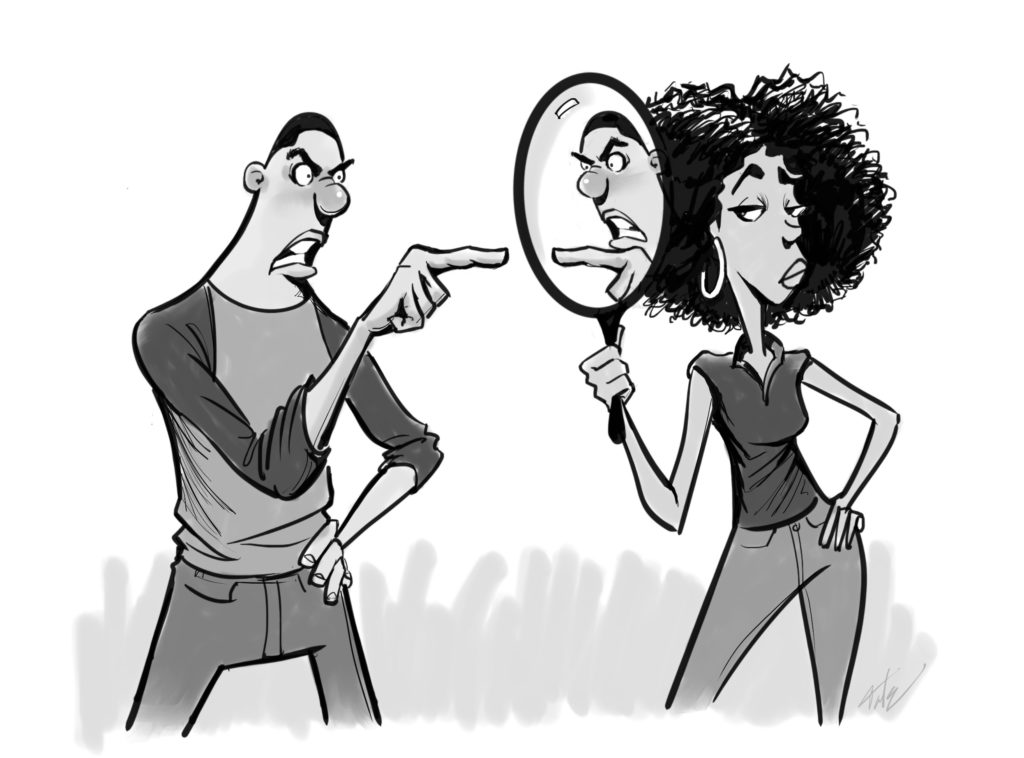Today, I will discuss Relationship No-No #3: Projection. My goal, is to bring this defensive strategy to light, and offer alternative routes to strengthening versus destroying bonds. Have you ever found yourself overly triggered by your partner and you don’t understand your own EXTRA LARGE feeling or response? Or your partner has told you that your reaction to an event is overly charged? We all do it. Whether it’s conscious or not is another story, and part of the solution.

How do projections form?
As children, we are raised in conditional environments. Our caregivers teach us through words, actions and feedback, what is acceptable and what is unacceptable. Children strive to gain the most love possible, so they formulate personality traits in this process. Traits or parts of themselves that are celebrated and rewarded are developed and strengthened, while traits and parts of self that are rejected, are suppressed and dissociated from.
A secondary form of repressing parts of the self, comes from witnessing a family member embodying traits that generated negative attention, such as alcoholic behavior, acting out, getting bad grades, etc. If a person witnesses this negative feedback from other family members or society towards their parent, sibling or an extended family member, they will likely repress that part of themselves to avoid the same.
As adults, these unaccepted traits dwell in the subconscious or unconscious. Let’s say someone grew up in a family where being down or depressed was not ok. They would work hard to be happy, joyful or up most of the time. Then, if a wave of depression emerged in daily life, they would feel shame and deny that part in themselves. If someone asks if they are down, they would likely deny it or not be in touch with it. These unconscious parts are what Carl Jung described as the shadow.
The shadow is simply the dark side of someone’s personality. And what is dark is always known only indirectly through projection. That is, one discovers his dark side as something belonging to others: friends, relatives, fictitious characters, etc. This is why the meeting with the personal shadow is considered to be a moral effort. The difficulty of integrate the shadow is huge, if we have to face alone this powerful figure.
https://www.carl-jung.net/
Shadow aspects can also show up in dreams. We might dream about someone we know, that represents a repressed and unacceptable part of ourselves, or as archetypal characters. In the example of the person who hides from being down, an archetype could be Oscar the Grouch!

How does a shadow express itself as a projection?
Let’s stick with the ‘no depression allowed’ example. The upbeat person is in relationship with someone who just lost their job. That person becomes down and depressed. While the happy-go-lucky partner might be understanding, the depression is hard for them. They might be constantly suggesting ways to cheer their partner up, but feel frustrated with them when they are not shifting their mood. The down partner, is representing the shadow side of being depressed. Even though it is circumstantial and will likely pass with the security of a new job, the other partner is subconsciously or unconsciously uncomfortable feeling this shadow within themselves.
Family of Origin Projection
As mentioned, another form of projection is from one’s family of origin. This style of projection is imagining unconsciously, subconsciously or consciously that one’s partner is acting like their primary caregiver, sibling, etc.. This attribution of characteristics can be positive or negative traits. For example, my partner tells really corny jokes just like my father (yes I am conscious of this) and I react with adoration or irritation just as I did with my father. I project the experience of my father into present time. An unconscious example of this, is a woman accusing her partner of being a scary monster when he gets angry and she withdraws as a result. Her father was scary when he got angry, yet she is not making the connection in that moment. Her partner becomes a scary monster, even if his expression of anger is minor. It is only with awareness that we can recognize the projections and utilize them towards healing.
Projection is like a camera lens: it changes what and how we see things
When we are dissociated from the part that is shadow projecting, it’s hard to even recognize that it’s happening. It is the lens we are looking through, and it can feel merged with our inner state. Just making yourself aware of what projection is and how it works, is the first step.
Recognizing the Projection as a powerful healing tool
The gift in it all, is activating shadow work within one’s self as well as in partnership. To make the unconscious, conscious and have freedom of choice.
Until you make the unconscious conscious, it will direct your life and you will call it fate.
― C.G. Jung
- Step 1 – Self Assess: If you can recognize that you are feeling triggered with your partner, and the response is EXTRA LARGE size versus just irritation, you are likely on the verge of projection whether you turn it inwards or outwards.
- Step 2 – Ask Yourself: Who am I imagining my partner to be right now? What archetype or role are they representing? Who in my family do they remind me of?
- Do some journaling about it, let yourself know what your mind is saying.
- Step 3 – Share Your Lightbulb Moment: When you can recognize what you might be projecting, be willing to share this vulnerable strength with your partner. Opening up at a deeper level is sexy and can build trust in the relationship. It is important that you ask your partner for listening and receiving, rather than any commentary on your awareness. It can be so deepening and powerful to share at this level with your partner.
- Step 4 – Bonus Points Relationship Challenge: Be brave enough to ask your partner, what role they feel you have cast them in. Let them be a helper to identify the shadow part at play. For example, he might say ‘I feel like I have been cast in the tight money guy role.’ If you are open, it may enlighten the awareness of your shadow, like ‘oh ya, I am projecting that you are my dad who is always afraid about money.’
- We are most equipped to help each other in relationship, because we have a front row seat to our partners. We know when they are centered and when they are off. While it can be hard to hear it from those who know us best, partners can be incredible advocates to shadow work.
- The KEY here, is to make sure you enlighten your partner’s shadow in the most KIND and RESPECTFUL manner. Tone and delivery is everything.
What if we are both projecting at the same time?
This is a tough one, and yet all too common. You see her as your angry mother, and the more withdrawn you get, the more frustrated she gets, and seems even more like your angry mother. She sees you as her passive father, who can’t stand up for himself. You are caught in a double projection, and no one is aware of it. It is a tug of war between shadow characters. This requires the emotional intelligence to become aware, and name it. Do not blame your partner. Simply name the paradigm. Be sure to take a pause to process internally first. It could be 10 minutes, 4 hours or a whole day before you come back together. Give it space to breath.
Try this
Write down the top 5 ways of being that bother you most about your partner (ie. negative moods, overspending, sarcasm, etc)
1.
2.
3.
4.
5.
These are your shadow parts, that you reject. They might also be aspects of your family of origin.
Write down the name of the person who fits each characteristic from your family or origin.
Reflect on these. When your partner is in a negative mood for example, you might be projecting what it was like for you when that was the case with your mother. How does that feel? Likely you feel stuck with the mood since you were a child and couldn’t fix it, even if you wanted to. Now you can’t fix it in your partner.
Making this conscious connection, you can untangle the projection, empathize with your younger self, and perhaps communicate this vulnerable aspect with your partner, so that they understand you more. I suggest that your partner reassure you, that it is not your job to lift their mood. You can find something to do for yourself when they are down, rather than for them.
The benefits of recognizing and communicating about projection
The benefits are two fold. First, you will have an opportunity to more deeply empathize with the rejected parts of you and free them. For example, if one of your shadow parts is being lazy, it is likely that you could use some laziness in your life if you have been avoiding it. It can be relaxing! My favorite quote is:
Until we become that which we have demonstrated against, we will have made no progress – unknown
The other benefit, is that you will feel closer, more trusting and free with your partner.
We must integrate the shadows to progress. To free ourselves and become whole. All of us have all of the parts, and this is why we are constant mirrors for each other in relationship. It is a gift to have triggers, because it highlights the areas for awareness we are seeking.
Artwork by Clark Tate http://clarktate.com/
If you’re not on my calendar and want to be, I am offering tele-medicine Video sessions through state of the art HIPAA compliant software. I am also offering EMDR Eye Movement Desensitization Reprocessing on Video. Book an online session or FREE 15 minute consultation here: https://valtate.com/
Anonymous says
Thank you so much for this amazing article!